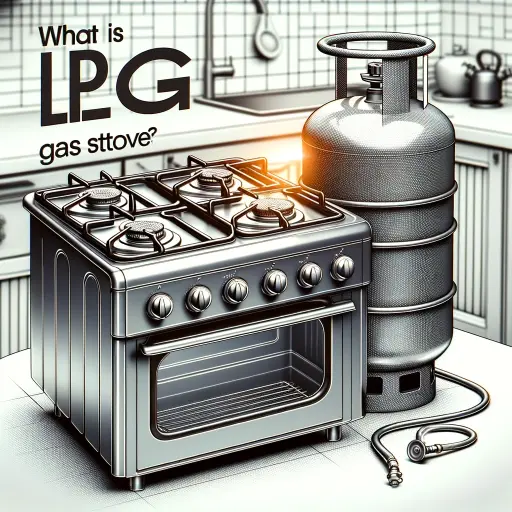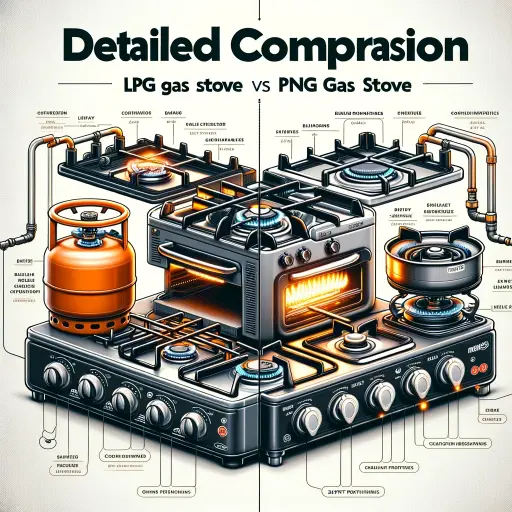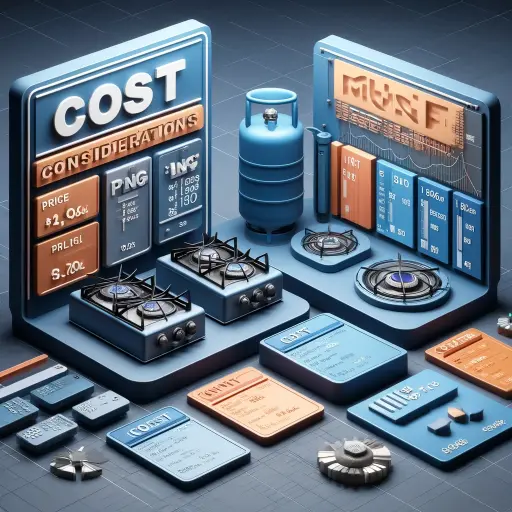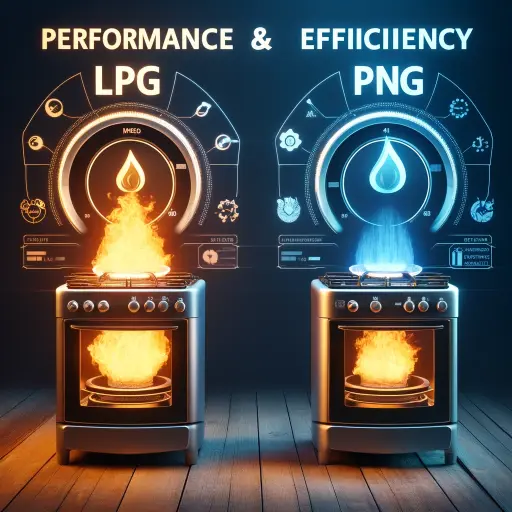Differences Between LPG And PNG Gas Stoves?
Updated: 19 Oct 2023
719
Choosing the right gas stove is a decision that impacts our daily lives more than we might realize. It’s not just about cooking efficiently, but also about safety, cost, and its impact on the environment. Knowing the Differences Between LPG And PNG Gas Stoves might help you make the right choice.
With the increasing popularity of both LPG (Liquefied Petroleum Gas) and PNG (Piped Natural Gas), making the right choice has become more important than ever.

In this guide, we’ll explore the key differences between LPG and PNG gas stoves, in plain and easy-to-understand language.
Differences Between LPG Gas stoves and PNG Gas Stoves
What is an LPG Gas Stove?
LPG, or Liquefied Petroleum Gas, is a type of flammable hydrocarbon gas. It’s a blend of propane and butane, known for its efficiency and versatility.

Composition and Properties of LPG
- LPG is primarily composed of propane (C3H8) and butane (C4H10).
- It is stored under pressure, allowing it to transition between liquid and gas states easily.
Source and Production Process
- LPG is extracted during the refining of crude oil and natural gas processing.
- It undergoes a purification process to remove impurities before being stored and distributed.
Availability and Common Uses
- LPG is available in portable tanks, making it accessible for both urban and rural areas.
- It’s widely used for heating, cooking, and even as fuel for vehicles in some cases.
What is a PNG Gas Stove?
PNG, or Piped Natural Gas, is a form of natural gas that’s supplied through pipelines directly to homes and businesses.

Composition and Properties of PNG
- PNG is primarily composed of methane (CH4), a lighter hydrocarbon than those found in LPG.
- It is odorless and colorless, requiring an added odorant for leak detection.
Source and Production Process
- PNG is extracted from underground gas reserves and processed to remove impurities.
- It’s then compressed and transported through pipelines to end-users.
Availability and Common Uses
- PNG is available in areas with established gas pipeline infrastructure.
- It’s commonly used for heating, cooking, and in some cases, for powering vehicles.
Which is Better PNG Gas Stove vs LPG Gas Stove
Quick Comparison
| Feature | LPG Gas Stove | PNG Gas Stove |
|---|---|---|
| Source of Gas | Cylinder-based | Pipeline from the main supply |
| Convenience | Requires manual cylinder replacement | Continuous supply, no need for replacement |
| Installation | Portable, easy to install | Requires pipeline installation, less portable |
| Cost of Setup | Lower initial setup cost | Higher initial setup cost due to infrastructure |
| Running Cost | Generally higher due to cylinder costs | Lower, as piped gas tends to be cheaper |
| Availability | Widely available | Limited to areas with pipeline infrastructure |
| Safety | Risks associated with cylinder leaks | Considered safer as it minimizes leak risks |
| Energy Efficiency | High efficiency | Slightly lower efficiency compared to LPG |
| Environmental Impact | Produces more CO2 emissions | Cleaner burning, less CO2 emissions |
Each type of gas stove has its advantages and considerations, depending on the user’s location, accessibility to gas supply, and specific needs.
LPG stoves offer portability and are common where piped gas isn’t available, while PNG stoves provide convenience and cost-efficiency in urban areas with established gas pipelines.
Detailed Comparison: LPG Gas Stove vs PNG Gas Stove

Safety Considerations
LPG Gas Stove Safety
Using LPG stoves requires careful attention to safety to prevent accidents and ensure smooth operation.
Potential Hazards and Precautions
- Hazard: Gas leaks leading to fire or explosions.
- Precaution: Regularly check for gas odors and promptly address any leaks.
- Hazard: Improper connections leading to gas leakage.
- Precaution: Ensure all connections are secure and properly fitted.
Proper Storage and Handling Guidelines
- Store LPG cylinders in well-ventilated areas away from heat sources or direct sunlight.
- Handle cylinders with care, avoiding rough handling or dropping.
Installation Best Practices:
Seek professional help for installation to ensure proper fitting and safety measures are followed.
PNG Gas Stove Safety
PNG stoves come with their own set of safety considerations due to their direct pipeline connection.
Unique Safety Considerations for PNG
- Regularly inspect and maintain the pipeline system for leaks or damages.
- Ensure that gas appliances are certified for use with PNG.
Safety Features of PNG Systems
PNG systems are equipped with automatic shut-off valves in case of leaks.
Precautions for Usage
Do not attempt to modify or repair PNG connections on your own. Seek professional assistance.
Installation Process

LPG Gas Stove Installation
Installing an LPG gas stove involves several crucial steps to ensure safety and efficiency.
Steps involved in installing an LPG gas stove
- Place the gas stove in a well-ventilated area, away from flammable materials.
- Connect the hose to the gas cylinder securely, ensuring no leaks.
- Check all connections for tightness using a soapy water solution to detect any bubbles.
- Test the stove burners to ensure they light properly and adjust for a clean, blue flame.
Necessary Equipment and Tools
- LPG gas cylinder with regulator and hose
- Gas pipe thread sealant
- Adjustable wrench, pipe wrench, and screwdrivers
- Leak detection solution (soapy water)
Professional Installation vs. DIY Options
- Professional Installation: Recommended for those unfamiliar with gas connections. A certified technician ensures all safety measures are met.
- DIY Installation: Suitable for those with experience in gas appliance installation. However, extreme caution is advised.
PNG Gas Stove Installation
Installing a PNG gas stove differs slightly due to the direct pipeline connection.
Steps involved in installing a PNG gas stove
- Attach the gas stove to the PNG pipeline using a certified connector.
- Test the stove burners to ensure they light properly and adjust for a clean, blue flame.
- Regularly inspect connections for leaks, especially during initial installation.
Necessary Equipment and Tools
- PNG gas stove with a compatible connector
- Pipe sealant (if required)
- Adjustable wrench and screwdrivers
Professional Installation vs. DIY Options
Professional Installation: Highly recommended for PNG connections to ensure proper sealing and safety measures.
DIY Installation: Not recommended due to the specialized nature of PNG connections. Seek professional assistance.
Cost Considerations
Understanding the financial aspects of choosing between LPG and PNG gas stoves is essential for making an informed decision.

Let’s explore the costs associated with each option.
Cost of LPG Gas Stove
Initial Investment
LPG Gas Stove: Purchasing an LPG stove involves a one-time cost. These stoves are generally affordable and widely available in the market.
Ongoing Operational Costs
Refilling LPG Cylinders: The primary operational cost for LPG stoves is the periodic refill of gas cylinders. The frequency of refills depends on the usage and cylinder capacity.
Routine Maintenance and Occasional Repairs: While LPG stoves are relatively low-maintenance, occasional servicing or repairs may be necessary over time.
Comparison with Other Cooking Fuels
Electric Stoves: Compared to electric stoves, LPG stoves usually have lower upfront costs. However, the cost of electricity for electric stoves can be more stable and predictable.
Induction Cooktops: Induction cooktops can have higher initial costs than LPG stoves, but they are generally more energy-efficient, potentially leading to lower long-term operational costs.
Cost of PNG Gas Stove
Initial Investment
PNG Gas Stove: Acquiring a stove compatible with PNG involves an initial investment. These stoves are designed specifically for use with natural gas.
Ongoing Operational Costs
Monthly PNG Subscription Fee (if applicable): Some regions may charge a monthly subscription fee for access to the piped natural gas network. This fee may vary depending on location and usage.
Routine Maintenance and Occasional Repairs: Like LPG stoves, PNG stoves may require occasional maintenance and repairs, though the frequency is generally lower.
Comparison with Other Cooking Fuels
Electric Stoves: Compared to electric stoves, PNG stoves can be more cost-effective in areas where natural gas is readily available
Environmental Impact
Understanding the environmental impact of LPG and PNG gas stoves is crucial for making an eco-conscious choice. Let’s explore how each option affects our environment.
Environmental Impact of LPG
Emissions and Carbon Footprint
Emissions: LPG combustion releases carbon dioxide (CO2) and other greenhouse gases into the atmosphere. While it produces fewer pollutants compared to some other fossil fuels, it still contributes to climate change.
Carbon Footprint: LPG has a relatively low carbon footprint compared to many other traditional fuels. Its combustion emits fewer harmful particles and pollutants.
Sustainability Initiatives in LPG Production
Efficiency Improvements: The industry is continuously working to enhance the efficiency of LPG production and distribution, reducing energy consumption and emissions.
Bio-LPG Production: Some efforts are being made to produce LPG from renewable sources, such as bio-based feedstocks, which can significantly lower its environmental impact.
Environmental Impact of PNG
Emissions and Carbon Footprint
Emissions: Piped Natural Gas (PNG) is primarily composed of methane, a potent greenhouse gas. While it burns cleaner than many other fossil fuels, uncontrolled methane emissions during production and transportation can contribute to climate change.
Carbon Footprint: The overall carbon footprint of PNG depends on factors such as production methods, distribution efficiency, and leak prevention measures.
Sustainability Initiatives in PNG Production
Methane Leak Detection and Prevention: Efforts are made to minimize methane leaks during the production and transportation of PNG. Advanced technologies and monitoring systems are employed to detect and address leaks promptly.
Renewable Natural Gas (RNG): Some regions are exploring the production of Renewable Natural Gas, a sustainable alternative to conventional PNG sourced from organic waste materials.
Performance and Efficiency

LPG Gas Stove Performance
Cooking Speed and Temperature Control
Cooking Speed: LPG stoves are known for their rapid heating capabilities, allowing for quick meal preparation.
Temperature Control: They provide precise control over flame intensity, enabling accurate adjustments to cooking temperatures.
Efficiency in Fuel Consumption
Efficient Use of Fuel: LPG stoves are generally efficient in converting gas to usable heat, resulting in lower overall fuel consumption.
Suitability for Different Cooking Methods
Versatility: LPG stoves are versatile and can accommodate various cooking techniques, from simmering to high-heat cooking.
PNG Gas Stove Performance
Cooking Speed and Temperature Control
Cooking Speed: PNG stoves offer similar cooking speeds to LPG stoves, ensuring efficient meal preparation.
Temperature Control: They provide precise control over flame intensity, allowing for accurate adjustments to cooking temperatures.
Efficiency in Fuel Consumption
Efficient Use of Fuel: PNG stoves are designed for optimal fuel efficiency, resulting in lower overall consumption.
Suitability for Different Cooking Methods
Versatility: PNG stoves are versatile and can handle various cooking techniques, from gentle simmering to high-heat tasks.
Maintenance Requirements
LPG Gas Stove Maintenance
Cleaning and Upkeep
Burners and Surfaces: Regularly clean burners and surfaces to prevent blockages and maintain efficient flame distribution.
Hoses and Connections: Check for wear or damage, and replace as needed.
Common Issues and Troubleshooting
Uneven Flame: Adjust burner caps and clean any clogs for an even flame.
Ignition Problems: Ensure the igniter is clean and properly aligned.
Scheduled Inspections and Servicing: Professional Inspections: Arrange for a certified technician to inspect your LPG stove periodically for leaks or malfunctions.
PNG Gas Stove Maintenance
Cleaning and Upkeep
Burners and Surfaces: Regular cleaning ensures optimal performance and even heating.
Piping and Connectors: Inspect for signs of wear or damage, and replace if necessary.
Common Issues and Troubleshooting
Irregular Flame: Adjust burners or have them cleaned if flame patterns become uneven.
Leak Detection: Be vigilant for any unusual odors, and if detected, turn off the gas supply and seek professional assistance.
Scheduled Inspections and Servicing: Professional Check-ups: Arrange for a certified technician to inspect your PNG stove periodically for leaks or malfunctions.
Convenience and Utility
LPG Stoves
Portability: LPG stoves offer the flexibility to be used in various locations, making them suitable for both urban and rural settings.
Availability: LPG cylinders are widely accessible, ensuring a reliable supply of fuel.
PNG Stoves
Continuous Supply: PNG stoves are connected directly to a gas pipeline, providing a constant and uninterrupted source of fuel.
No Cylinder Handling: With PNG, there’s no need to handle heavy cylinders, adding to user convenience.
Long-term Benefits
Considering the long-term advantages of using LPG or PNG gas stoves is crucial for making an informed decision.
Let’s explore the conveniences, utilities, and other lasting benefits associated with each option.
Conclusion
In conclusion, choosing between LPG and PNG stoves involves weighing factors such as safety, convenience, and environmental impact. Once you know the differences between LPG and PNG Gas Stoves, it will be easier for you to make the right choice.
Depending on your specific circumstances and location, one option may offer more benefits than the other. Always consider your unique needs and consult with professionals for the best choice.
Please Write Your Comments